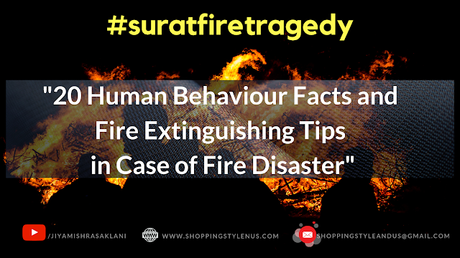 #SuratFireTragedy devoured 21 lives on Friday, 24th May'19 at Takshashila Complex in Surat. I doubt that we lost only 21 lives, it could be more than that looking at the size of the building and impact of the fire. Devilish smoke coming out of the fourth floor and smothering people whose lives perished into nothing after jumping off the building because of the suffocation.
#SuratFireTragedy devoured 21 lives on Friday, 24th May'19 at Takshashila Complex in Surat. I doubt that we lost only 21 lives, it could be more than that looking at the size of the building and impact of the fire. Devilish smoke coming out of the fourth floor and smothering people whose lives perished into nothing after jumping off the building because of the suffocation.After working for approximately 2+ years as a Business Continuity Manager and a Disaster Recovery Coordinator, I have developed a sense of seriousness, responsibility and desperation for such events. I felt like suing the Fire Department. The ladders could not reach even 3rd floor failing to save those those who were able to escape fire, but got stuck amid suffocating smoke and the uneasiness compelled them to take the plunge from the 4th floor.
What started the fire is the matter of investigation. But the crowd response in the videos I watched made me a little sick in my stomach. But they are not to blame!
According to the physiological, psychological, and social behavioral studies, at times of urgency, people tend to make unsound situational judgments and take wrong actions and, at times, even lose consciousness. Shouting loudly, losing confidence, disregarding exhortations, running in all directions, etc. are typical behaviors of people confronted with emergency situations.
Let's see one more case which is very similar like Takshashila Complex fire:
On 14 November 2008, at the Shanghai Business College in China, a dormitory room at the sixth floor caught fire at 6:10am in the morning. The fire expanded very quickly and gave off a lot of smoke. The door was incidentally closed. The four trapped girls fell back to try to keep away from the fire. Eventually, the fire flame spread to the balcony. The girls jumped from the balcony before the firefighters arrived. They may have thought it was safer to do so, yet none of them could survive. The police received the fire report at 6:12am. The firefighters soon arrived, and the fire was put out at 6:30am. If there had been an assistance system, which could adaptively advise the four trapped girls to use the sheets in the dormitory and tie them to their bodies and climb down to the lower floors, e.g. the fifth floor, rather than directly jump down to the ground, their lives might have been saved.
In life-critical urgent situations, people lose lives due to bad judgment and poor decisions. In Surat tragedy, many fractured their hands while catching the falling students. Some just watched and tried to keep them from taking the plunge. Some shot videos and some just stood stunned. I was devastated and all I could do was read about it. So, I read some books about fire evacuation system and found 20 interesting facts about human behaviour, ire extinguishing and evacuation tips in case of a fire disaster.
1. Crowded spaces are prone to accidents and many casualties in case of fire or other emergency situations. They can happen in large buildings or urban spaces. Predicting crowds’ behavior is crucial for creating adequate simulators that practitioners can use for evaluating evacuation scenarios in such emergency cases. 2. To accomplish this goal, a good knowledge of human behavior, both individual as well as collective (when in a crowd) is needed. 3. A human's movement in normal situation has its own dynamics. For instance, when walking along a sidewalk, in case of head-on encounters, a binary decision takes place: pedestrians need to choose whether to evade the other person on the right-hand or on the left-hand side. This decision process goes along with a significant decrease of walking speed. This is an example of the interaction processes that happen between people walking at normal pace. 4. However, most of the normal behavior vanishes when we face an emergency situation. 5. As people try to leave the building as fast as possible, the desired velocity augments which leads to some characteristic formations. As nervousness increases there is less concern about the comfort zone and finding the most convenient and shortest way. 6. The decision-making process of crowds and their dynamics under emergency situations is a crucial aspect that needs further investigation. 7. Individuals in a crowd show similar behaviors when acting in group. 8. It is important to attend to the different approaches taken so far to tackle this same problem using BDI (Beliefs, Desires, Intentions) architectures. 9. Fire threatens the lives. Some of the physical injuries will take a long time to heal, and the mental injuries can take even longer. 10. Look around your office or workplace. Anything that contains wood, plastic, paper, fabric, or combustible liquids can fuel a fire.11. The key ingredients of a fire are:
a. Fuel. Any combustible material. b. Oxygen. The air we breathe is approximately 20 percent oxygen, more than enough to nurture a fire. c. Heat. Something to raise the fuel’s temperature until it combusts. d. Remove any of these elements and a fire will cease to burn. 12. A smell of smoke is usually the first indication that a fire is under way. Early detection (either human or mechanical) at this early stage can trigger fire suppression efforts before significant loss occurs. 13. As the fire reaches the end of the smoldering phase, flames will become visible. Once flames have appeared, the fire will begin to spread. The temperature of the burning object will quickly exceed 1,800 degrees Fahrenheit. At this point, a room’s contents will ignite, structural fatigue becomes possible, and occupant lives become seriously threatened. Within five minutes, the room temperature will be high enough to ignite all combustibles within the room. At this point, most contents will be destroyed and human survival becomes impossible. 14. Wood contains all sorts of stuff, such as water, minerals, and volatile organic compounds. As the heat source applied to the wood exceeds 300 degrees Fahrenheit, the volatile organic compounds begin evaporating. This is typical of a smoky fire. 15. The easiest and cheapest thing is to identify and eliminate potential fire hazards, and educate people about these risks. 16. Hire a fire safety engineer consultant to evaluate the adequacy of your existing fire evacuation plan and suppression systems. If money is an issue, invite the local fire department team to perform this task. They will provide free evaluations of a structure’s fire risk, indicating both recommended and required changes. 17. Well-marked emergency exits that are kept free from clutter.If sources are to be believed, Takshashila Complex had only one exit. 18. Fire extinguishers can be used to contain very fires, but they lack the capacity to attack large fires. The contents of a fire extinguisher determine the type of fire for which it is best suited.
19. Remember the acronym PASS while using a fire extinguisher:
a. Pull the pin.b. Aim at the base of the flames.
c. Squeeze the trigger.
d. Sweep from side to side
20. Fire evacuation guidelines to follow:
a. Do not fight fires unless you are confident of your ability to put them out.b. Trigger the closest fire alarm.
c. Leave the area quietly and calmly.
d. Do not wait for others.
e. Do not hold hands with others.
f. Go to the nearest exit.
g. If doors are closed, use the push bar or the emergency door release switches found next to doors.
h. Walk. Do not run or push others.
i. Keep to the sides of the aisles, stairs, and corridors. Do not walk in the middle.
j. Women should take off high heels if they obstruct movement.
k. Do not use the elevators. Use only emergency exits.
l. When reaching the assembly point, call the emergency services.
m. Report any person you think is still inside.
n. Never go back to the building without emergency officials’ permission.
o. Do not argue with emergency officials and always follow their instructions.
p. If the fire is outside the room, close the door and use available materials to close holes or gaps where flames and smoke can pass through. q. If smoke enters the room, stay close to the ground as smoke tends to rise. If there are windows around, open them and signal your position if possible
21. Every building should have these in each and every room:
a. Fire Evacuation Plan b. Emergency Numbers c. Fire extinguishers d. Blankets and Ropes e. Sand f. A team specially trained to handle such crisis scenariosREFERENCES
1. Business Continuity Management: Choosing to Survive 2. Context-Aware Computing 3. Advances in Artificial Transportation Systems and Simulation
*This post may contain affiliate links, products sent by brand/PR for consideration or paid content.Disclosure Policy.

